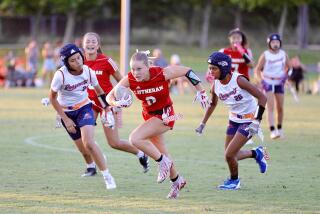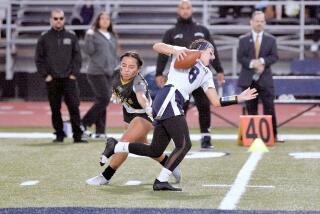Fencing Has Added Thrust Since ’84 Olympics
- Share via
It’s unlike any other sport.
Many people don’t even think of it as a sport, regarding it as something that takes place on a movie set, not in a gym.
It is a sport with virtually no physical contact, yet its enthusiasts consider it a fusion of mind and body.
The sport is fencing, and thanks to the infusion of surplus money from the 1984 Olympic Games in Los Angeles, and in this Olympic year, the groundwork is there for a growth of popularity.
You can find 50 to 70 fencers on weekday nights and Saturday at the Westside Fencing Center on Washington Boulevard in Culver City, home of the Salle Gascon Fencing Club. Phyllis Elliott, its manager, says 200 to 300 people come to the club regularly, but they are not members.
“We don’t force money out of anybody,” said Elliott. “This is a center for the community.”
Salle Gascon was founded by Theodore Katzoff, now the fencing master along with Ed Richards. Katzoff and Elliott spearheaded the effort to build the club four years ago. Before it became a fencing center, the space was a woodworking shop.
“The trash was piled up to our waist,” said Elliott. “There was dust everywhere.” But all that changed when a crew from the fencing community worked every weekend to make the area a fencing center.
And what a center it is. Working entirely off floor and instruction fees, the salle (French for club) now boasts six grounded fencing strips, a theater arts room and an instruction loft. The walls are decorated with photos of champions. Chandeliers that look as if they are from the 18th Century hang above the strips.
Colorful banners hang from the walls, representing each of the 11 fencing clubs in the Los Angeles area. Some have classic names and others are less formal, like Salle Borracho in Pomona. Borracho means “drunk” in Spanish. Salle Gascon takes its name from the French province of Gascony, home of legendary swordsman Cyrano de Bergerac.
You can’t get away from characters like Cyrano at the Westside Fencing Center. A proclamation by the city of Los Angeles declaring March 6, 1988, Cyrano de Bergerac Day hangs by the office. A photograph of the late Errol Flynn brandishing a sword hangs across from the proclamation. Upstairs near the instruction area is a picture of actress Shelley Long, who trained with Katzoff for a scene in “Outrageous Fortune.”
“The only link people have with fencing is Errol Flynn in late-night movies,” said Katzoff. “But it’s a very good introduction. It gives people a hint of fencing.”
Swordplay has been a major source of adventure for film watchers from the time of Errol Flynn in “Robin Hood” all the way to Val Kilmer in recently released “Willow.”
Katzoff has a long history in show business and theater. He was Barbara Billingsley’s first TV son in a ‘50s situation comedy called “Professional Father.” But more recently, and significantly, he has helped actors in swordplay and choreographed duels. Katzoff has also worked on “The Princess Bride.”
But Katzoff’s ability goes beyond movies. Last fall Katzoff and company appeared in “The Ring of Steel” at the Mark Taper Forum, a production of classic literature involving swordplay. Katzoff also designed the battle sequence involving 28 swordsmen in a Hollywood Bowl performance of Beethoven’s “Wellington’s Victory” three summers ago.
Salle Gascon instructor Wayne Sitz believes theatrical productions are more difficult than actual fencing. “Every 60 seconds of (theatrical) swordplay requires 40 hours of rehearsal,” Sitz says.
Oh, and they also do some real fencing at the center. The sport comes from the art of dueling. When dueling with swords was outlawed in Europe and the United States, sportsmen began to use swords with blunted tips and developed a new sport. The word fence comes from the same word as defense , meaning a guard against danger, or barrier.
There are three separate weapons used in fencing, each with its own target area--the foil for the torso, the epee for the entire body and the saber for the upper body. The epee is a descendant of a dueling weapon and still has a blood well running down its blade.
Here’s how fencing works. A director’s (referee’s) command of En garde, fence! begins a bout. In preliminary tournament rounds, five touches by a fencer earn a victory. Hence, the exclamation Touche! In elimination rounds, women fence to eight touches, men to 10. There is a mandatory two-point victory margin, with a maximum point total of 12.
The foil and epee are judged electronically. Fencers using these weapons are attached to wires. Every time a fencer touches his opponent with the tip of his weapon in the correct target area, a circuit is completed, a buzzer sounds, and a red light goes on above the strip. White lights signal an illegal touch. Fencing strips are about 42 by 6 feet.
The saber is still judged by humans, since touches can be recorded by the edges of the sword, called slashing. U.S. Fencing Assn. official Frank Widder said European officials are testing experimental electronic judging systems for saber that should be in general use by the 1990s.
Fencers compete from September to June, earning points for high finishes in tournaments. At the end of the year, champions are determined by points and a national championship tournament. Though this is technically the off-season, fencing officials are still excited about the results of the June national championships in Cleveland. Fifteen fencers from Southern California finished in the nation’s top 20 in various weapons and divisions.
“So many people did well, in so many events,” said Widder. “People tended to peak at the same time.”
Salle Gascon received the national award for outstanding performances by juniors, based on the results of the national championships.
Al Carter of West Los Angeles won the under-19 foil championship and earned a place on the junior Pan-American team. Geoff Russell of Venice was the under-20 points champion in epee and is also a member of the junior Pan-Am team. Nick Bravin of West L.A. was the under-17 points champion with the foil and is an alternate for the Pan-Am team. Chanel Summers of Los Angeles earned a place on the women’s junior Pan-Am team. This year’s Pan-Am Games in October are in Brazil. Carter, Russell, Bravin, and Summers are all from Salle Gascon.
In women’s epee, Redondo Beach resident Xandy Brown of Salle Couturier in Culver City won the Division I championship. Unfortunately, only foil is contested at the Olympics for women, so Brown must stay home.
The junior fencers at Salle Gascon are typical of Southern California fencers, said Sitz, who instructs many of the juniors there. Before they discovered Salle Gascon, they knew very little about the sport and were not very athletic in the traditional sense, Sitz said. Now they have competed all over the country and will compete on the international level at the Pan-Am games.
“I started to fence because my parents wanted me to do something different,” Carter said. “I didn’t know anything about the sport before I started.”
“If I had to recommend a sport to someone who said, ‘I want to be in international competition,’ it would have to be fencing,” Sitz said.
Fencing appeals to people who are not good at team sports and want to try something different. Elliott, an erstwhile opera singer, began fencing to relax her upper body and became so enamored with the sport that she initiated the search for a fencing center site. She enjoys the chivalric ideals of fencing for your salle and the adventure of swordplay.
The other night at Westside, Elliott talked about her favorite pastime.
“I love the fairy tale idea of two opponents in a duel who respected each other so much they parted as friends,” said Elliott.
Romance is alive and well at Westside, but don’t get fencing wrong, warns Katzoff; underneath the plumes and capes is an intense sport.
“It involves speed, strength and the ability to change direction and make decisions in split seconds,” Katzoff said. “It’s like ballet with a sword.”
Fencing still doesn’t enjoy the same popularity in the United States as it does in Europe, but the fencing association and the Amateur Athletic Foundation of Los Angeles are working to get more young people fencing. The foundation, created by surplus funds from the 1984 Olympics, has established a fund for a high school development program. So far, 10 schools participate. In comparison to major sports, fencing has a long way to go.
“There’s a huge untapped resource in Southern California,” Sitz said.
“We’d like to tap minority areas. Fencing still attracts people from upper economic levels,” Elliott said. Ideally, fencing would become so popular that the fencing center could support itself without having Elliott donate as much as 35 hours a week in addition to her full-time job.
Is it worth it?
“Oh yes,” Elliott said. “It’s worth it whenever someone walks in here and they can do a skill that they never thought they could do.”
More to Read
Go beyond the scoreboard
Get the latest on L.A.'s teams in the daily Sports Report newsletter.
You may occasionally receive promotional content from the Los Angeles Times.






